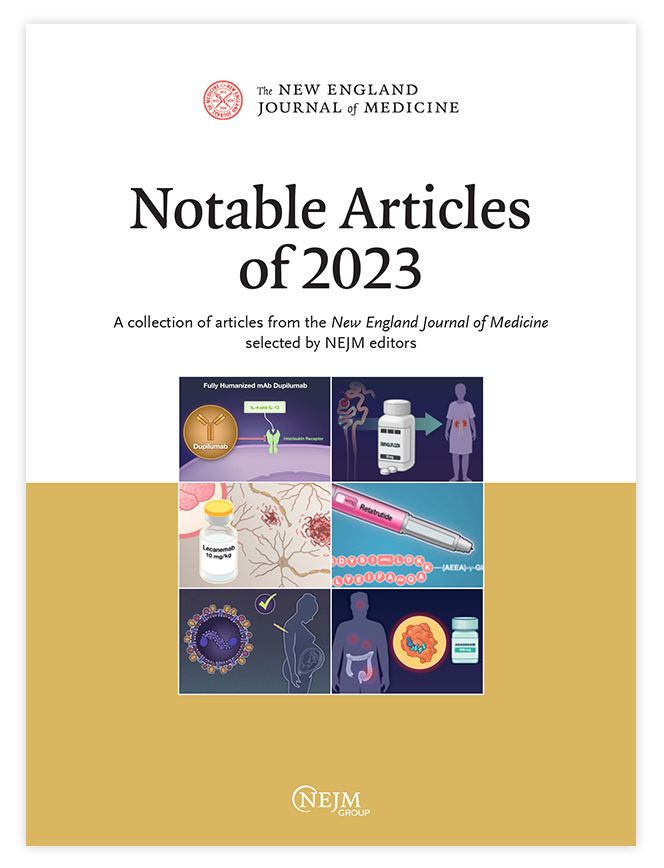Efruxifermin in Compensated Liver Cirrhosis Caused by MASH.
IF 96.2
1区 医学
Q1 MEDICINE, GENERAL & INTERNAL
引用次数: 0
Abstract
BACKGROUND In phase 2 trials involving patients with stage 2 or 3 fibrosis caused by metabolic dysfunction-associated steatohepatitis (MASH), efruxifermin, a bivalent fibroblast growth factor 21 (FGF21) analogue, reduced fibrosis and resolved MASH. Data are needed on the efficacy and safety of efruxifermin in patients with compensated cirrhosis (stage 4 fibrosis) caused by MASH. METHODS In this phase 2b, randomized, placebo-controlled, double-blind trial, we assigned patients with MASH who had biopsy-confirmed compensated cirrhosis (stage 4 fibrosis) to receive subcutaneous efruxifermin (at a dose of 28 mg or 50 mg once daily) or placebo. The primary outcome was a reduction of at least one stage of fibrosis without worsening of MASH at week 36. Secondary outcomes included the same criterion at week 96. RESULTS A total of 181 patients underwent randomization and received at least one dose of efruxifermin or placebo. Of these patients, liver biopsy was performed in 154 patients at 36 weeks and in 134 patients at 96 weeks. At 36 weeks, a reduction in fibrosis without worsening of MASH occurred in 8 of 61 patients (13%) in the placebo group, in 10 of 57 patients (18%) in the 28-mg efruxifermin group (difference from placebo after adjustment for stratification factors, 3 percentage points; 95% confidence interval [CI], -11 to 17; P = 0.62), and in 12 of 63 patients (19%) in the 50-mg efruxifermin group (difference from placebo, 4 percentage points; 95% CI, -10 to 18; P = 0.52). At week 96, a reduction in fibrosis without worsening of MASH occurred in 7 of 61 patients (11%) in the placebo group, in 12 of 57 patients (21%) in the 28-mg efruxifermin group (difference from placebo, 10 percentage points; 95% CI, -4 to 24), and in 18 of 63 patients (29%) in the 50-mg efruxifermin group (difference from placebo, 16 percentage points; 95% CI, 2 to 30). Gastrointestinal adverse events were more common with efruxifermin; most events were mild or moderate. CONCLUSIONS In patients with compensated cirrhosis caused by MASH, efruxifermin did not significantly reduce fibrosis at 36 weeks. (Funded by Akero Therapeutics; SYMMETRY ClinicalTrials.gov number, NCT05039450.).依鲁西弗明在MASH代偿性肝硬化中的作用。
背景:在涉及由代谢功能障碍相关脂肪性肝炎(MASH)引起的2期或3期纤维化患者的2期试验中,efruxifermin(一种二价成纤维细胞生长因子21 (FGF21)类似物)可减少纤维化并解决MASH。对于由MASH引起的代偿性肝硬化(4期纤维化)患者,efruxifermin的有效性和安全性还需要数据。方法:在这项2b期、随机、安慰剂对照、双盲试验中,我们将活检证实代偿性肝硬化(4期纤维化)的MASH患者分配给皮下艾夫昔芬(剂量为28mg或50mg,每日一次)或安慰剂。主要结果是在第36周时,至少一个阶段的纤维化减少而MASH没有恶化。第96周的次要结果包括相同的标准。结果共有181名患者接受了随机分组,并接受了至少一剂量的头孢昔芬或安慰剂。在这些患者中,有154例患者在36周时进行了肝活检,134例患者在96周时进行了肝活检。在36周时,安慰剂组61例患者中有8例(13%)出现纤维化减少而MASH没有恶化,28 mg埃夫昔弗明组57例患者中有10例(18%)出现纤维化减少(调整分层因素后与安慰剂的差异为3个百分点;95%置信区间[CI], -11 ~ 17;P = 0.62), 50 mg艾夫昔弗明组63例患者中有12例(19%)(与安慰剂相比,差异为4个百分点;95% CI, -10 ~ 18;p = 0.52)。在第96周,安慰剂组61例患者中有7例(11%)出现纤维化减少而MASH没有恶化,28 mg埃夫昔弗明组57例患者中有12例(21%)出现纤维化减少(与安慰剂相比,差异为10个百分点;95% CI, -4至24),50 mg埃夫昔弗明组63例患者中有18例(29%)(与安慰剂相比,差异为16个百分点;95% CI, 2 ~ 30)。胃肠道不良事件更常见的efruxifermin;大多数事件都是轻微或中度的。结论在MASH引起的代偿性肝硬化患者中,艾夫昔弗明在36周时没有显著减少纤维化。(由Akero Therapeutics资助;网站编号:NCT05039450)。
本文章由计算机程序翻译,如有差异,请以英文原文为准。
求助全文
约1分钟内获得全文
求助全文
来源期刊

New England Journal of Medicine
医学-医学:内科
CiteScore
145.40
自引率
0.60%
发文量
1839
审稿时长
1 months
期刊介绍:
The New England Journal of Medicine (NEJM) stands as the foremost medical journal and website worldwide. With an impressive history spanning over two centuries, NEJM boasts a consistent publication of superb, peer-reviewed research and engaging clinical content. Our primary objective revolves around delivering high-caliber information and findings at the juncture of biomedical science and clinical practice. We strive to present this knowledge in formats that are not only comprehensible but also hold practical value, effectively influencing healthcare practices and ultimately enhancing patient outcomes.
 求助内容:
求助内容: 应助结果提醒方式:
应助结果提醒方式:


